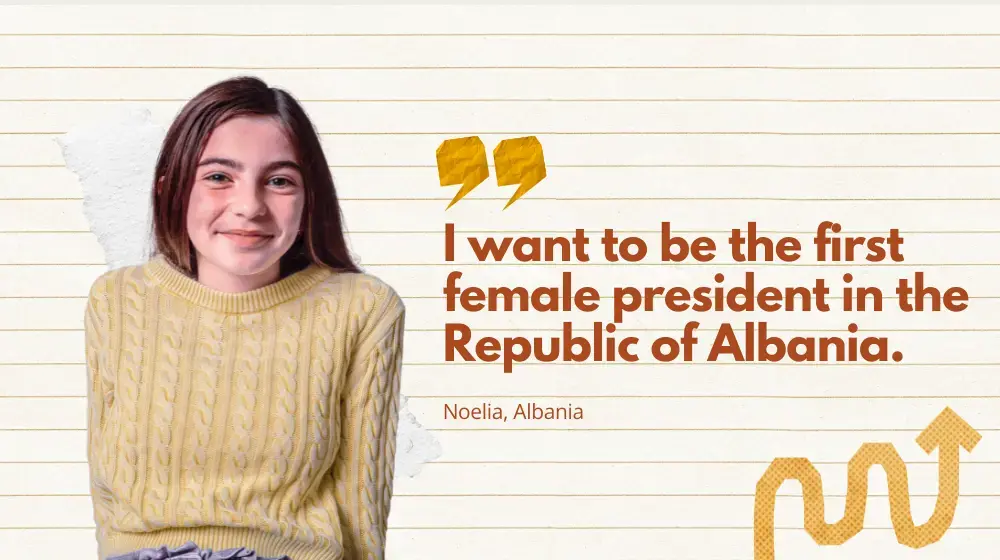Today, an unprecedented 600 million adolescent girls are coming of age around the world.
They hold tremendous promise not only as individuals but as agents of change for progress in society. When girls are given the resources and opportunities to realize their aspirations, their families, communities, economies and future generations grow stronger as well.
And yet despite these benefits, girls continue to be seen in some places as less valuable and even a burden compared to male offspring. One of the harmful practices of this mindset is son preference that results in gender-biased sex selection, which is prevalent and persistent in parts of the Western Balkans and South Caucasus regions.
The International Day of the Girl Child on 11 October is a time to recognize that every girl counts and that they face unique challenges in their lives. It is also a time to work toward overcoming these barriers that stand in the way of girls achieving their full potential in the world.
Demographic dangers of undervaluing girls
Gender-biased sex selection can manifest before a child is born when people use abortion to avoid the birth of a female foetus or choose only to implant male embryos.
When this happens in large numbers it leads to a skewed sex ratio at birth. In natural human biology, boys slightly outnumber girls at a rate of around 105 male births for every 100 females. South-Eastern and Eastern Europe largely followed this trend until the early 1990s after the Soviet Union collapsed. The ensuing economic and social turmoil pushed many couples to have fewer children and more traditional attitudes returned, where sons were viewed as the pillars of the family who could earn more income and care for the parents as they aged.
The impact was clear and devastating: UN data shows that between 2000 and 2020, the sex ratio at birth began to skew. Azerbaijan saw the widest gap, with an annual average of around 114 male births for every 100 female births. In rural parts of the country, the ratio could be as high as 120 to 100. The only other country in the world that had a larger imbalance during this period was China.
Neighbouring countries like Armenia (113) and Georgia (108) as well as Albania (109) and Kosovo (107) in the Western Balkans also registered some of the highest sex ratio gaps in the world. UNFPA has estimated that due to these harmful practices, more than 171,000 girls were “missing” in the region.
Over time, this enormous cohort of “missing girls” can distort a country’s demographics and create social imbalances.
UNFPA estimates that if the disparity in Azerbaijan’s sex ratio at birth continues or worsens, up to 15,000 more boys than girls will be born each year by 2050. For women, that could cause even wider gender gaps in education, employment and other spheres of life. For men, it risks causing a rise in involuntary bachelorhood as the surplus number of men are excluded from the marriage market. This so-called “marriage squeeze” – which primarily affects poor and rural men from vulnerable sections of society – could result in a surge in outmigration and population decline as well as a rise in human rights violations against women such as human trafficking, gender-based violence and forced marriage.
“Whoever has a daughter, has the world”
While the latest sex ratios at birth in Azerbaijan (113), Armenia (108), Albania (107), Georgia (107) and Kosovo (108) remain above expected levels, progress has been made since the 2000s to gradually lessen the gap and combat the practices that created such skewed ratios.
UNFPA has worked with governments and local partners to advocate for laws and policies that protect the rights of girls and women, such as banning gender-biased sex selection and granting equal inheritance rights to all children.
But perhaps most importantly, UNFPA is working to shift the attitudes that undervalue girls within their family and society.
Campaigns have been launched targeting the gender-biased language that is commonly used to describe pregnancies. For example, UNFPA in Albania promoted the slogan “Next time, I hope it’s a girl” – a rebuttal to the intense pressure that mothers often face to have a son.
In Kosovo, the prime minister marked last year’s Day of the Girl Child by releasing a video where he expressed his joy at being the father of a girl using another idiom “Whoever has a daughter, has the world.”
Meanwhile, the “EU 4 Gender Equality” programme jointly implemented by UNFPA and UN Women, with funding from the European Union, has established Fathers’ Schools in countries including Armenia, Azerbaijan and Georgia. They encourage men to embrace a more supportive and inclusive approach to parenting and partnership, which challenges traditional gender roles and family dynamics while also empowering women to contribute beyond household care responsibilities. The programme in Azerbaijan, in particular, focused on helping men resist the discriminatory social norms against daughters.
When children feel valued, supported and protected – regardless of their sex – it fosters an environment where everyone can feel confident in who they are and pursue their dreams to the fullest.









